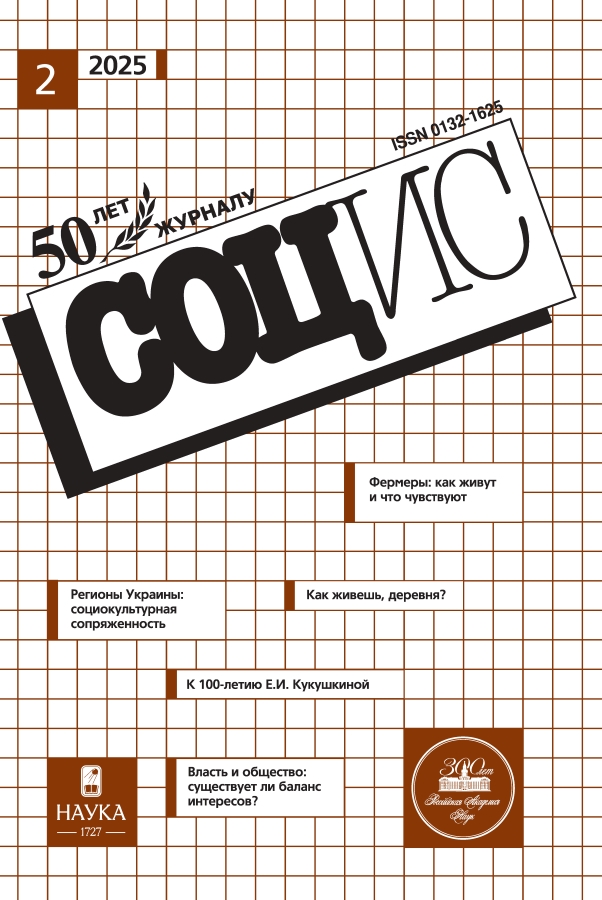Farming: lifeworld and social well-being
- Authors: Velikiy P.P.1
-
Affiliations:
- Saratov Federal Scientific Center of the Russian Academy of Sciences
- Issue: No 2 (2025)
- Pages: 29-39
- Section: ANNYVERSARY
- URL: https://ruspoj.com/0132-1625/article/view/682082
- DOI: https://doi.org/10.31857/S0132162525020037
- ID: 682082
Cite item
Abstract
The article presents the results of a sociological study of Russian farming. The author proceeds from the conceptual setup of farming, which emerged in Russia during the agrarian reform of 1994–2000, as a fundamentally new form of economic and socio-cultural connections and relations, unknown in the Soviet reality. After more than thirty years of functioning, the actors of this life way, firstly, have become the most prosperous layer among rural residents, have mastered new styles of behavior, secondly, they experience more diverse moral and emotional challenges in the course of implementing their life activities. The author substantiated the demand for science and management tasks to identify the fields of the life world of farmers – material, social and spiritual, and also analyzed their content. As a real problem, the proportionality of entry and presence in the fields of the life world of farmers of three age groups (youth, middle and old age) is highlighted. Being subjects oriented toward the constant streamlining of all components of the economy, farmers are more active in comparison with non-entrepreneurs in communication from the positions of “profitable-unprofitable”, “useful or useless”, “I don’t want to get in touch, but it might be useful”. Moreover, this assessment also applies to partners, communication with whom is formalized and therefore inevitable, nevertheless, it is also emotionally colored, since psychological and emotional relationships are connected in the everyday life of people’s life worlds. The criterion of where these relationships cross the boundaries of what is due and acceptable is the depth of the farmer’s morality as an individual. In the conditions of the farmer’s life, many temptations arise when it is possible to solve problems of profit by increasing resources or reducing costs, therefore ambivalence is also present in the choice of actions. The use of proportionality of farmers’ participation in a wider space of the life world as a target indicator allows one to adjust a number of social functions of this socio-structural group, and more accurately assess its capabilities as a participant in social actions to maintain the sustainability of life of the population of rural areas and settlements.
Full Text
About the authors
Peter P. Velikiy
Saratov Federal Scientific Center of the Russian Academy of Sciences
Author for correspondence.
Email: iagpran@mail.ru
Doctor of Philosophy, Professor, Leading Researcher
Russian Federation, SaratovReferences
- Belyaeva L. A. (2010) Standard and quality of life. Problems of measurement and interpretation. In: Milestones of Russian Sociology 1950–2000s. Ed. by Zh. T. Toshchenko, N. V. Romanovsky. St. Petersburg: Aletheia. (In Russ.)
- Velikiy P. P. (2024) Farming is an (Un)Rooted Social Group: Problem Statement. Sotsiologicheskie issledovaniya [Sociological Studies]. No. 5: 79–88. (In Russ.)
- Grouping of Peasant (farm) Households and Individual Entrepreneurs by Size of Agricultural Land (as of August 1, 2021) (2022). In: Main results of the 2021 agricultural microcensus. Statistical collection / Federal State Statistics Service. Moscow: IRC “Statistics of Russia”. (In Russ.)
- Indexes in statistics (2002). In: Large Encyclopedic Dictionary. St. Petersburg: Norint Publ. (In Russ.)
- Kvale S. (2003) Research interview. Moscow: Smysl.
- Kuchenkova A. V., Tatarova G. G. (2024) Subjective Well-Being: the Problem of Analyzing Population Qualitative Heterogeneity (Part 1). Sotsiologicheskie issledovaniya [Sociological Studies]. No. 4: 14–25. (In Russ.)
- Myagkov A. Yu. (2015) Diagnostics and measurement of students’ social well-being: towards substantiation of the methodology. Sociology of education. No. 7: 102–113. (In Russ.)
- Nekrasov N. A. (1981) Reflections at the front entrance In: Complete works and letters in 15 volumes. L.: Nauka,. Vol. 2. (In Russ.)
- Osinsky I. I., Butueva Z. A. (2015) Social well-being: concept, formation factors and measurement indicators. Bulletin of BSU. No. 14: 38–45. (In Russ.)
- Tatarova G. G., Kuchenkova A. V. (2016) Indicators of subjective well-being as characteristics for typology building. Sotsiologicheskie issledovaniya [Sociological Studies]. No. 10: 21–32. (In Russ.)
- Heidegger M. (2003) Being and time / Per.: V. V. Bibikhina. Kharkov: Folio. (In Russ.)
Supplementary files










